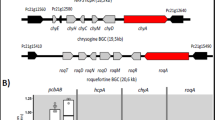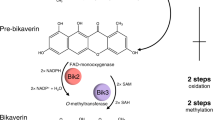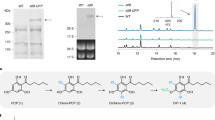Abstract
Basidiomycetes are known to biosynthesize many biologically interesting compounds, including terpenoids. However, they are notoriously difficult to manipulate. Previously, we identified the gene cluster encoding enzymes responsible for the biosynthesis of lagopodins, cuparene-type sesquiterpenoid quinone natural products in Coprinopsis cinerea. In this study, we attempted to increase the productivity of lagopodin B (1) and related pathway products by overexpressing the terpene cyclase gene cop6 in C. cinerea to determine the details of the complex lagopodin and hitoyol biosynthetic pathway. Random integration of the cop6 into the genome of the ku70-deficient C. cinerea strain resulted in an ~2.4-fold increase in the production of 1. However, integration of cop6 into a highly transcribed position within the chromosome we designated as an expression boost area (EBA) resulted in an ~14-fold greater production of 1. Furthermore, the EBA-integration strain allowed us to isolate a previously undetected product 2, which we determined to be the known compound, hydroxylagopodin B. This finding expanded our understanding of the lagopodin–hitoyol biosynthetic pathway and allowed us to hypothesize a possible mechanism for the biosynthesis of a related homodimeric compound, lagopodin C. Our results demonstrate the potential of targeting EBA to integrate key biosynthetic genes into the genome for enhancing the production of difficult-to-obtain compounds for studying the biosynthesis of complex secondary metabolites in basidiomycetes and other complex eukaryotic organisms.
This is a preview of subscription content, access via your institution
Access options
Subscribe to this journal
Receive 12 print issues and online access
$259.00 per year
only $21.58 per issue
Buy this article
- Purchase on SpringerLink
- Instant access to full article PDF
Prices may be subject to local taxes which are calculated during checkout





Similar content being viewed by others
References
Stajich JE, Wilke SK, Ahrén D, Au CH, Birren BW, Borodovsky M, et al. Insights into evolution of multicellular fungi from the assembled chromosomes of the mushroom Coprinopsis cinerea (Coprinus cinereus). Proc Natl Acad Sci USA. 2010;107:11889–94.
Masuya T, Tsunematsu Y, Hirayama Y, Sato M, Noguchi H, Nakazawa T, et al. Biosynthesis of lagopodins in mushroom involves a complex network of oxidation reactions. Org Biomol Chem. 2019;17:234–9.
Liu YZ, Li YY, Sun YF, Zheng ZH, Song SY, Su WJ, et al. Highly acetylated lanostane-type triterpenoids from Coprinus cinereus 120. Helv Chim Acta. 2012;95:282–5.
Lagoutte R, Winssinger N. Following the lead from nature with covalent inhibitors. Chimia. 2017;71:703–11.
Bills GF, Gloer JB. Biologically active secondary metabolites from the fungi. Microbiol Spectr. 2016;4:1–32. FUNK-0009-2016.
Agger S, Lopez-Gallego F, Schmidt-Dannert C. Diversity of sesquiterpene synthases in the basidiomycete Coprinus cinereus. Mol Microbiol. 2009;72:1181–95.
Otaka J, Hashizume D, Masumoto Y, Muranaka A, Uchiyama M, Koshino H, et al. Hitoyol A and B, two norsesquiterpenoids from the basidiomycete Coprinopsis cinerea. Org Lett. 2017;19:4030–3.
Otaka J, Shimizu T, Futamura Y, Hashizume D, Osada H. Structures and synthesis of hitoyopodins: bioactive aromatic sesquiterpenoids produced by the mushroom Coprinopsis cinerea. Org Lett. 2018;20:6294–7.
Muraguchi H, Umezawa K, Niikura M, Yoshida M, Kozaki T, Ishii K, et al. Strand-specific RNA-Seq analyses of fruiting body development in Coprinopsis cinerea. PLoS One. 2015;10:e0141586.
Liu Y, Srivilai P, Loos S, Aebi M, Kues U. An essential gene for fruiting body initiation in the basidiomycete Coprinopsis cinerea is homologous to bacterial cyclopropane fatty acid synthase genes. Genetics. 2006;172:873–84.
Nakazawa T, Ando Y, Kitaaki K, Nakahori K, Kamada T. Efficient gene targeting in ΔCc.ku70 or ΔCc.lig4 mutants of the agaricomycete Coprinopsis cinerea. Fungal Genet Biol. 2011;48:939–46.
Nakazawa T, Tatsuta Y, Fujita T, Nakahori K, Kamada T. Mutations in the Cc.rmt1 gene encoding a putative protein arginine methyltransferase alter developmental programs in the basidiomycete Coprinopsis cinerea. Curr Genet. 2010;56:361–7.
Nakazawa T, Honda Y. Absence of a gene encoding cytosine deaminase in the genome of the agaricomycete Coprinopsis cinerea enables simple marker recycling through 5-fluorocytosine counterselection. FEMS Microbiol Lett. 2015;362:fnv123.
Chen S, Zhou Y, Chen Y, Gu J. fastp: an ultra-fast all-in-one FASTQ preprocessor. Bioinformatics. 2018;34:i884–90.
Kim D, Paggi JM, Park C, Bennett C, Salzberg SL. Graph-based genome alignment and genotyping with HISAT2 and HISAT-genotype. Nat Biotechnol. 2019;37:907–15.
Li H, Handsaker B, Wysoker A, Fennell T, Ruan J, Homer N, et al. The sequence alignment/map format and SAMtools. Bioinformatics. 2009;25:2078–9.
Pertea M, Pertea GM, Antonescu CM, Chang TC, Mendell JT, Salzberg SL. StringTie enables improved reconstruction of a transcriptome from RNA-seq reads. Nat Biotechnol. 2015;33:290–5.
Nakazawa T, Ishiuchi K, Sato M, Tsunematsu Y, Sugimoto S, Gotanda Y, et al. Targeted disruption of transcriptional regulators in Chaetomium globosum activates biosynthetic pathways and reveals transcriptional regulator-like behavior of aureonitol. J Am Chem Soc. 2013;135:13446–55.
Sugano SS, Suzuki H, Shimokita E, Chiba H, Noji S, Osakabe Y, et al. Genome editing in the mushroom-forming basidiomycete Coprinopsis cinerea, optimized by a high-throughput transformation system. Sci Rep. 2017;7:1260.
Tsunematsu Y, Ishikawa N, Wakana D, Goda Y, Noguchi H, Moriya H, et al. Distinct mechanisms for spiro-carbon formation reveal biosynthetic pathway crosstalk. Nat Chem Biol. 2013;9:818–25.
Winter JM, Cascio D, Dietrich D, Sato M, Watanabe K, Sawaya MR, et al. Biochemical and structural basis for controlling chemical modularity in fungal polyketide biosynthesis. J Am Chem Soc. 2015;137:9885–93.
Gottlieb HE, Kotlyar V, Nudelman A. NMR chemical shifts of common laboratory solvents as trace impurities. J Org Chem. 1997;62:7512–5.
Liu C, Minami A, Ozaki T, Wu J, Kawagishi H, Maruyama JI, et al. Efficient reconstitution of basidiomycota diterpene erinacine gene cluster in ascomycota host Aspergillus oryzae based on genomic DNA sequences. J Am Chem Soc. 2019;141:15519–23.
Tsunematsu Y, Takanishi J, Asai S, Masuya T, Nakazawa T, Watanabe K. Genomic mushroom hunting decrypts coprinoferrin, a siderophore secondary metabolite vital to fungal cell development. Org Lett. 2019;21:7582–6.
Bottom CB, Siehr DJ. Hydroxylagopodin B, a sesquiterpenoid quinone from a mutant strain of Coprinus macrorhizus var. Microsporus Phytochem. 1975;14:1433.
Bollinger P. Ueber die konstitution und konfiguration der lagopodine A, B und C. Switzerland: Eidgenosichen Technischen Hockshule Zürich; 1965.
Wang P, Gao X, Tang Y. Complexity generation during natural product biosynthesis using redox enzymes. Curr Opin Chem Biol. 2012;16:362–9.
Ishiuchi K, Nakazawa T, Yagishita F, Mino T, Noguchi H, Hotta K, et al. Combinatorial generation of complexity by redox enzymes in the chaetoglobosin A biosynthesis. J Am Chem Soc. 2013;135:7371–7.
Acknowledgements
We wish to thank the financial support from the Japan Society for the Promotion of Science (JSPS) (KW, 16H06449; 19H02898; 19K22291; 19KK0150; YT, 17K15265; 20K05866), the Takeda Science Foundation (KW), the Institution of Fermentation at Osaka (KW), the Japan Antibiotics Research Association (KW), the Uehara Memorial Foundation (KW), and the HOKUTO Bio-chemical Research Foundation (KW).
Author information
Authors and Affiliations
Corresponding author
Ethics declarations
Conflict of interest
The authors declare that they have no conflict of interest.
Additional information
Publisher’s note Springer Nature remains neutral with regard to jurisdictional claims in published maps and institutional affiliations.
Rights and permissions
About this article
Cite this article
Asai, S., Tsunematsu, Y., Masuya, T. et al. Uncovering hidden sesquiterpene biosynthetic pathway through expression boost area-mediated productivity enhancement in basidiomycete. J Antibiot 73, 721–728 (2020). https://doi.org/10.1038/s41429-020-0355-9
Received:
Revised:
Accepted:
Published:
Issue Date:
DOI: https://doi.org/10.1038/s41429-020-0355-9
This article is cited by
-
Recent advances in understanding the regulation of plant secondary metabolite biosynthesis by ethylene-mediated pathways
Physiology and Molecular Biology of Plants (2024)
-
Biosynthesis and regulation of terpenoids from basidiomycetes: exploration of new research
AMB Express (2021)
-
Genomics-directed activation of cryptic natural product pathways deciphers codes for biosynthesis and molecular function
Journal of Natural Medicines (2021)



